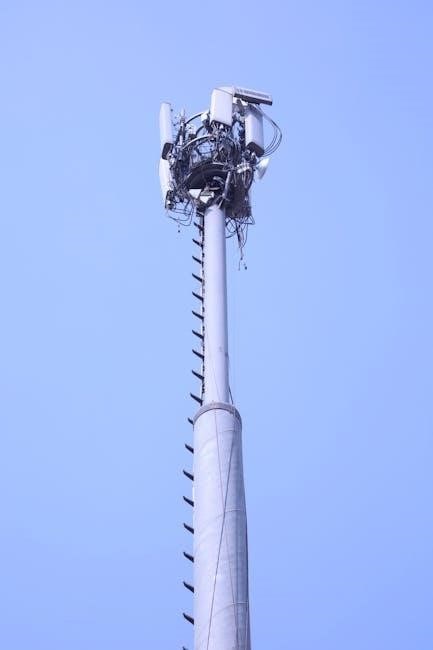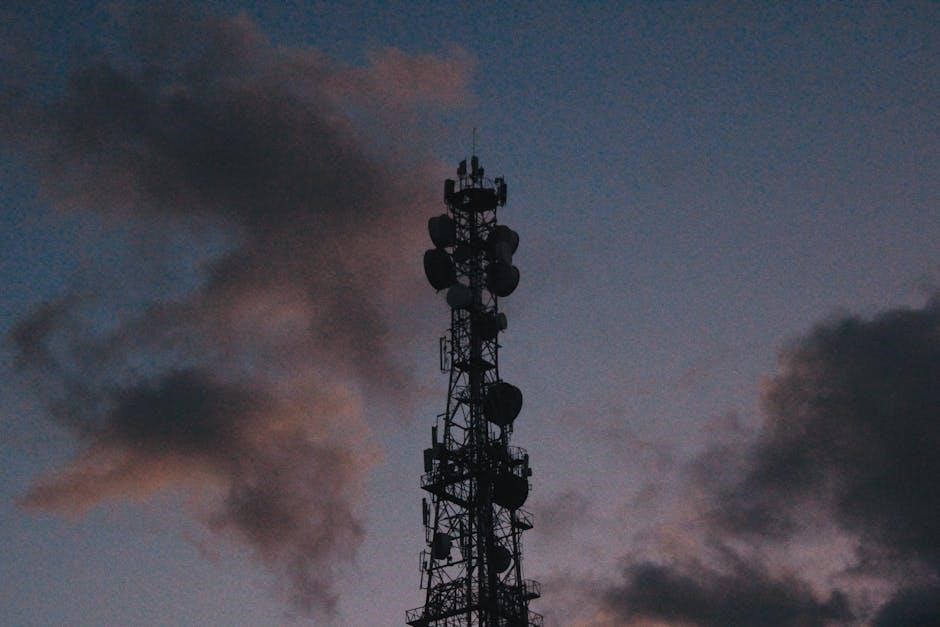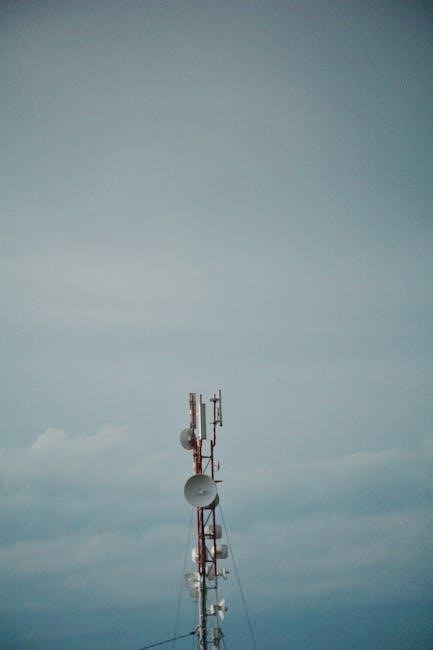
Cell phone towers, or base stations, are structures with electronic equipment and antennas that send and receive signals to and from cell phones, enabling communication and connectivity.
Physical Components of Cell Towers
Cell towers include a sturdy structure, antennas, transmitters, and support systems, designed to ensure reliable communication over extensive areas while enduring various environmental stresses.
Tower Structure
The tower structure is a critical component, providing the framework to support antennas and equipment. Typically constructed from steel or concrete, these towers vary in height and design, ranging from 50 to over 400 feet. Guyed towers use cables for stability, while self-supporting towers rely on their own strength. Monopole towers are single-pillar structures, often preferred for urban areas due to their sleek design. The tower’s height and design are chosen based on signal coverage needs, terrain, and environmental factors. Structural integrity is ensured through rigorous engineering and materials, with foundations deeply anchored to withstand wind and seismic activity. Regular maintenance ensures longevity and safety, making the tower structure vital for reliable communication networks. These structures are adaptable, catering to diverse deployment scenarios while maintaining aesthetic and functional requirements.
Foundation and Anchoring
The foundation and anchoring system of a cell phone tower are essential for its stability and longevity. Typically, towers are anchored using deep concrete footings or spread foundations, depending on soil conditions. Guyed towers often require additional anchor points, buried underground, to secure the supporting cables. Anchor bolts and guy wires are used to ensure the tower remains upright under wind and seismic stress. The foundation depth can vary, with some extending 30 feet or more below ground level to distribute weight evenly. Proper anchoring prevents tower collapse and ensures signal reliability. Regular inspections of the foundation and anchoring systems are critical to maintain structural integrity and safety. These systems are designed to withstand extreme weather conditions, ensuring uninterrupted communication services. The durability of the foundation directly impacts the tower’s performance and lifespan, making it a vital component of the overall structure.

Antenna Systems
Antenna systems on cell towers include various types like directional and omnidirectional antennas, mounted on structures to transmit and receive RF signals, ensuring reliable network coverage and communication.
Types of Antennas
Cell phone towers utilize various antenna types to ensure efficient signal transmission and reception. Directional antennas, such as sector antennas, focus signals in specific directions, improving coverage in targeted areas. Omnidirectional antennas, on the other hand, broadcast signals in all directions, providing broader coverage. Dipole antennas are simple and effective for basic communication needs. Parabolic dishes are used for long-range, high-frequency signals, often in microwave communication. Additionally, specialized antennas like phased arrays and multi-band antennas are employed to support multiple frequencies and advanced network requirements. Each type is selected based on the tower’s location, coverage needs, and the frequency of operation, ensuring optimal performance and reliability in the cellular network.

Antenna Mounting Structures
Antenna mounting structures are critical components of cell phone towers, ensuring antennas are securely fastened and positioned for optimal signal transmission. These structures include rooftop mounts, guyed towers, and monopoles, each designed to accommodate different antenna types and environmental conditions. Rooftop mounts are ideal for urban areas, allowing antennas to blend with existing architecture, while guyed towers provide additional support for larger or heavier antenna systems. Monopoles are sleek, single-pole structures that house antennas internally, minimizing visual impact. The choice of mounting structure depends on factors like location, weight capacity, and desired aesthetic integration. Proper installation and alignment of these structures are essential to maintain signal strength and network reliability. Regular maintenance ensures stability and performance, while adherence to safety standards protects both equipment and personnel during installation and servicing.

Transmitters and Receivers
Transmitters convert electrical signals into radio waves, broadcasting them through antennas, while receivers detect and decode incoming signals, ensuring clear communication between cell phones and the tower.
Function of Transmitters
Transmitters in cell phone towers play a crucial role in converting electrical signals into radio waves, which are then broadcast through antennas to mobile devices. They handle voice calls, data transmission, and SMS services, ensuring reliable communication. By amplifying signals, transmitters maintain strong connectivity over long distances, compensating for signal loss due to obstacles like buildings or terrain. They operate on specific frequencies, minimizing interference and ensuring high-quality transmission. Transmitters also support multiple users simultaneously, managing data rates and signal strength dynamically. Their functionality is essential for enabling seamless communication and connectivity in cellular networks, making them a cornerstone of modern telecommunications infrastructure.
Types of Transmitters
Cell phone towers utilize various types of transmitters to ensure efficient signal transmission. Analog transmitters are used for older networks, supporting basic voice and limited data services. Digital transmitters are more advanced, handling high-speed data and multimedia services. Hybrid transmitters combine analog and digital capabilities, catering to both legacy and modern networks. MIMO (Multiple Input Multiple Output) transmitters enhance capacity by using multiple antennas to serve numerous users simultaneously. Additionally, fiber-optic transmitters are employed in modern networks, offering high-speed data transmission with minimal signal loss. Each type is designed to meet specific network requirements, ensuring reliable connectivity and optimal performance. These transmitters are crucial for maintaining seamless communication in cellular networks, adapting to evolving technological demands.
Receivers
Receivers in cell phone towers detect and decode signals from mobile devices, ensuring clear communication. They work alongside transmitters to maintain seamless two-way connectivity, enhancing network efficiency and reliability.
Role of Receivers
Receivers play a critical role in cell phone towers by detecting and processing signals transmitted from mobile devices. They ensure that communication is maintained by accurately decoding incoming data, voice, and SMS. Receivers work in tandem with transmitters to facilitate seamless two-way communication, enabling reliable connectivity for users. Their primary function is to capture weak signals from mobile phones and strengthen them for processing. This ensures that calls, texts, and data transmissions are clear and uninterrupted. Receivers also help in managing signal strength and quality, which is essential for maintaining network performance. By effectively handling incoming signals, receivers contribute to the overall efficiency and capacity of the cellular network, ensuring that users experience consistent and high-quality service. Their role is vital in supporting the increasing demand for mobile communication in both urban and rural areas.
Types of Receivers
Cell phone towers utilize various types of receivers to ensure optimal signal detection and processing. The primary types include superheterodyne receivers, direct conversion receivers, and software-defined radio (SDR) receivers. Superheterodyne receivers are widely used for their high sensitivity and ability to handle multiple frequency bands. Direct conversion receivers, on the other hand, are simpler in design and convert radio signals directly to baseband, offering better noise performance. Software-defined radio receivers are highly flexible, allowing reconfiguration through software updates to adapt to changing network demands. Each type of receiver is selected based on specific requirements such as frequency range, signal strength, and interference mitigation. These receivers play a crucial role in maintaining clear and reliable communication, ensuring that signals from mobile devices are accurately captured and processed. Their design and functionality are tailored to meet the demands of modern cellular networks.

Power Supply and Backup Systems
Cell towers rely on primary power sources like electrical grids and backup systems such as diesel generators or batteries to ensure uninterrupted operation during outages or maintenance.
Primary Power Sources
Primary power sources for cell phone towers typically include electrical grids, which provide consistent and reliable energy. These grids are connected to the tower’s infrastructure, ensuring continuous operation. In urban areas, towers often have direct access to mains electricity, while in remote locations, they may rely on underground cables or overhead lines. The electrical supply is distributed through transformers and circuit breakers to meet the tower’s energy demands. Additionally, some towers incorporate renewable energy sources, such as solar panels or wind turbines, to reduce reliance on traditional power grids. These systems are designed to be efficient and scalable, ensuring that the tower’s power needs are met without interruption. The primary power source is critical for maintaining network connectivity and supporting the tower’s electronic components. Its reliability is essential for seamless communication services.
Backup Power Solutions
Backup power solutions are essential for cell phone towers to ensure uninterrupted service during outages. The most common solutions include diesel generators and battery banks. Diesel generators provide long-term backup power, while batteries offer immediate, short-term support. These systems are designed to activate automatically when the primary power source fails. In addition, some towers use uninterruptible power supply (UPS) systems to bridge the gap during generator startup. Regular maintenance of these backup systems is critical to ensure reliability. Environmental considerations, such as noise and emissions from diesel generators, are also addressed through proper installation and regulations. Backup power solutions are vital for maintaining network connectivity and preventing service disruptions, especially in remote or disaster-prone areas. Their effectiveness ensures that communication services remain available even under challenging conditions. This redundancy is a cornerstone of modern telecommunications infrastructure.

Safety Measures
Cell phone towers require strict safety measures, including compliance with industry standards, regular maintenance, and emergency protocols. Proper training and equipment ensure safe operations and minimize risks effectively always.
Safety Compliance
Safety compliance is critical for cell phone towers to ensure the well-being of personnel and the public. Regulatory bodies, such as OSHA and FCC, enforce strict guidelines to minimize risks. These standards address RF exposure limits, structural integrity, and electrical safety. Compliance ensures that towers operate within safe parameters, protecting both workers and nearby communities. Regular inspections and audits are conducted to verify adherence to these regulations. Non-compliance can result in penalties and operational shutdowns. Proper signage, access restrictions, and training for maintenance crews are essential components of compliance. By following established protocols, cell phone towers can operate safely, reducing potential hazards and ensuring reliable service delivery. Compliance also extends to environmental and health standards, ensuring that towers do not pose unacceptable risks to humans or wildlife. Adherence to these measures is non-negotiable in the telecommunications industry.

Emergency Procedures
Emergency procedures for cell phone towers are designed to address unexpected events, such as equipment failure, natural disasters, or unauthorized access. These protocols ensure the safety of personnel, the public, and the tower’s infrastructure. In case of an emergency, the primary step is to isolate the affected area and shut down power supplies to prevent further damage. Emergency response teams are trained to handle situations like fires, structural instability, or severe weather damage. Communication with local authorities and service providers is critical to minimize service disruptions. Regular drills and maintenance checks help prepare for potential crises. Additionally, backup systems, such as generators, are activated to maintain partial service during outages. Emergency procedures also include evacuation plans and first aid measures for workers. Proper documentation and post-emergency assessments are conducted to identify root causes and improve future responses. These measures ensure that cell phone towers can recover quickly and safely from unforeseen events.
Environmental Considerations
Environmental considerations for cell phone towers involve assessing their ecological impact, such as habitat disruption and emissions. Mitigation strategies include using eco-friendly materials and reducing energy consumption to minimize their footprint.
Environmental Impact Assessment
An Environmental Impact Assessment (EIA) for cell phone towers evaluates potential ecological effects, such as habitat disruption, noise pollution, and electromagnetic emissions. The process involves analyzing the tower’s location, height, and surrounding flora and fauna to minimize harm. Key factors include soil stability, water resources, and nearby wildlife habitats. Assessments also consider long-term effects like visual pollution and land use changes. Mitigation strategies may involve using stealth designs or eco-friendly materials to blend towers into the environment. Regular monitoring ensures compliance with environmental regulations and addresses community concerns. The goal is to balance technological advancement with sustainable practices, ensuring that cell phone towers coexist harmoniously with nature and local ecosystems;
Mitigation Strategies

Mitigation strategies for cell phone towers focus on reducing their environmental and visual impact while maintaining functionality. One approach is the use of stealth designs, where towers are disguised as trees, flagpoles, or other structures to blend into the surroundings. Another strategy involves deploying antennas in existing infrastructure, such as rooftops or utility poles, to minimize new construction. Technological advancements, like beamforming antennas, can also reduce electromagnetic emissions. Site selection plays a crucial role, with towers placed in areas of least ecological sensitivity. Additionally, implementing noise reduction measures and using eco-friendly materials can further mitigate environmental concerns. Community engagement and transparent communication about tower locations and safety are also essential. These strategies aim to balance the need for reliable connectivity with environmental and aesthetic considerations, ensuring sustainable deployment of cell phone towers.

Maintenance Practices
Regular maintenance ensures cell phone towers operate efficiently, involving inspections, equipment checks, and repairs to uphold performance and safety standards, while addressing potential issues promptly.
Maintenance Scheduling
Maintenance scheduling for cell phone towers is critical to ensure optimal performance and reliability. Regular inspections and servicing are typically planned quarterly or annually, depending on environmental conditions and usage. These schedules include checks for antenna alignment, transmitter functionality, and power systems. Technicians also monitor for signs of wear, such as rust or loose connections, to prevent failures. Advanced systems use predictive maintenance, analyzing data to anticipate issues before they occur. Scheduling is often coordinated to minimize downtime, with most work done during low-traffic hours. Proper maintenance scheduling ensures uninterrupted service, protects equipment longevity, and maintains safety standards. It also allows for timely upgrades, adapting to technological advancements and increasing network demands. This structured approach is essential for maintaining seamless communication services in a rapidly evolving digital landscape.
Routine Maintenance Procedures
Routine maintenance for cell phone towers involves systematic checks and procedures to ensure optimal functionality. Technicians inspect antennas, transmitters, and receivers to identify issues like misalignment or damage. Cleaning debris from antennas and ensuring proper grounding are essential tasks. Testing signal strength and transmission quality helps verify performance. Software updates for transmitters and receivers are regularly applied to enhance efficiency and security. Visual inspections of the tower structure, including bolts and guy wires, are conducted to prevent structural failures. Power systems, such as batteries and generators, are tested to ensure reliability during outages. These procedures are documented to track maintenance history and plan future schedules. Regular maintenance ensures uninterrupted service, prevents equipment degradation, and maintains safety standards. It also helps in identifying potential issues before they escalate, ensuring seamless network operation and user connectivity.
